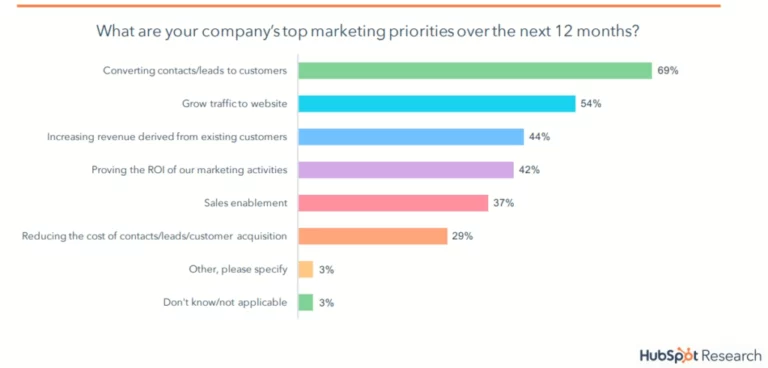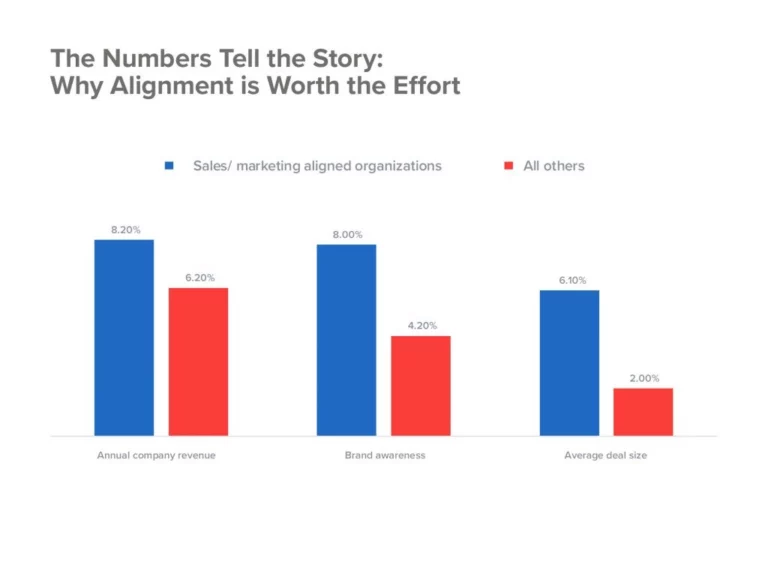
Introduction
Irrespective of the industry they are in, sales teams are always struggling to have more people purchase the products or services they sell. According to HubSpot’s 2018 State of Inbound Report, B2B sales teams are faced with a wide range of challenges as they go about their work.
These include securing responses from prospects, prospecting quality leads, closing leads, connecting with prospects and getting different decision makers in B2B companies to engage. In fact, statistics show that the priority of marketing teams in B2B companies is to turn leads into customers.

Source: HubSpot
The account-based marketing (ABM) approach can help inside sales teams to solve these issues and increase sales significantly. With more companies embracing ABM each day, this marketing strategy encourages B2B companies to focus on cultivating valuable relationships with high value leads.
Unlike conventional marketing strategies that focus on reaching a wide audience, companies that embrace ABM narrow their focus to selected high value leads and target them with relevant content and offers that are well aligned with their needs. This means setting up an account for every prospect, treating each prospect as a unique market and developing targeted sales and marketing messages for the individual targets.
Why Loop In The Inside Sales Team
With the widening range of communication tools, remote selling is becoming the in thing. Today, inside selling has become the dominant way of selling for a significant number of B2B products such as PaaS and SaaS. Inside sales teams no longer have to reach prospects directly. Increased internet bandwidth, communication services and customer preference for online purchases makes it easier for inside sales teams to do pretty much everything they need to do remotely.
This saves B2B companies a whole lot of money as studies place the cost of inside calls at a high of $75 compared to a high of $400 for outside calls. Because of the efficiency and cost effectiveness that an inside sales team offers your company, it becomes necessary to increase their productivity with ABM.
This does not require a drastic change in their fundamental process. Rather, they need to become more realistic in selecting accounts and be more resourceful in outreach to begin winning with ABM campaigns. In this article, we share three ways B2B inside sales teams can win with ABM campaigns.
How Inside Sales Teams Can Win with ABM Campaigns
1. Aligning Efforts of Inside Sales Teams With Those of Marketing Teams
When it comes to growing B2B sales revenues, marketers have a preference for data while sales teams rely on their guts. In ABM campaigns, inside sales teams don’t have to let go of their experience in the use of instincts nor do marketers have to overlook data. Instead, the ABM approach creates an environment where both teams can utilize their strengths to increase customer accounts and sales revenue.
B2B companies can combine these strengths to enable inside sales teams to win in ABM campaigns in selecting the right prospects to target. But with at least 45% of B2B companies struggling with sales and marketing alignment, how can your company achieve this?

Source: Quarry.com
In the ABM approach, B2B companies identify and focus their sales and marketing efforts on high value customers. Since identification of the right prospects remains one of the greatest challenges in implementation of ABM strategies, B2B companies should have both sales and marketing teams engage in this process.
A good place for the teams to start is by discussing the vision they have of an ideal prospect and agreeing on a criterion for determining what constitutes a right account. The marketing team should complement the intuition of sales teams by evaluating a wide range of data about possible prospects including:
- Company information including size, staffing, growth, locations etc
- Intent data including content downloads, ad clicks, engagement in forums and topics that employees search for in third party sites
- Engagement data such as previous purchases, existing connections with the company, executive entry points and current coverage of decision makers
Once the right prospects have been identified, individual salespersons can decide which accounts to pursue and the sales teams can leverage individual strengths to maximize sales.
Other areas that sales teams and marketing teams need to work together are:
A). Developing Customer Personas:
In this process, marketing teams identify customer details such as companies, key stakeholders and the positions or titles they hold and business priorities. On the other hand, sales teams provide insights about customer pain points
B). Determining The Right Content for Selected Prospects:
The two teams have to work together to ensure prospects get relevant content. Alignment in content determination is particularly critical where there is a change in customer personas. ABM meetings between the two teams come in handy with marketing teams focusing on reviewing existing content while inside sales teams provide feedback on the pieces that work best.
C). Content Dissemination Strategy:
B2B companies should have a multi-channel content dissemination that aligns inside sales teams and marketing teams. Marketing teams have a bigger role in pushing content out through the company website, social channels, guest websites, emails and among others.
On the other hand, sales teams will play a strategic role in content dissemination by integrating content in phone calls, remote meetings and personal emails. Alignment between the two teams is required to ensure that targeted prospects do not receive content that is not relevant to the stage they are on the customer journey.
D). Tracking Results:
Though tracking engagement metrics is largely a marketing function, there is a need to collaborate with inside sales teams to track sales pipeline metrics. The teams will also need to work together to track and measure new contacts that are identified, accounts that get mapped and new leads that are engaged.
2. Getting An In-Depth Understanding of Prospects
ABM creates the much needed alignment between marketing teams and inside sales teams. When you have these teams working together, your company is likely to net more sales.

Source: Super Office
Marketers develop multiple ideal customer profiles that help inside sales teams to identify the most valuable prospects. Sales teams on the other hand provide information on the most critical customer profiles in their deals. This means any ABM campaign your company runs will involve the use of data in selection of high value prospects. This data is often based on the ideal customer profiles developed by marketers.
B2B customer profiles also identify various decision makers that need to be targeted during the sales process. During ABM campaigns, B2B marketers dig into customer historical data and provide inside sales teams with the resources they need to connect with decision makers in the target prospect. This provides sales teams the clarity on who to target in each deal and shortens the deal cycle significantly.
Inside sales teams can boost their sales by ensuring that they engage multiple decision makers – which significantly cuts down the amount of time it takes to close or even increase deal size. This is because the more people are involved in a deal, the higher the chances of the deal materializing. In simple terms, ABM enables marketers to boost the success of inside sales teams by informing and expanding their lead nurturing leads and deal closure efforts.
3. Leveraging Strategic Team Connections To Reach Prospects
The ABM approach thrives on using important details about high value prospects to effectively interact and nurture leads. The important information that a B2B company has about prospects is a valuable asset that inside sales teams can use to win deals.
By leveraging different members of the sales team, the sales department can evaluate high-value prospects and understand the different decision makers in each prospect. This includes knowing who in the team is strategically connected to an influential prospect in the target account and finding the most effective way to communicate to them.
Even where a B2B company has equipped its inside sales teams with the most socially adept tools, the benefits of being introduced by a person who knows a prospect at personal level are invaluable.
There are many ways that technology helps with since. Inside sales teams can use LinkedIn to initiate contact. They could also tap other tools such as Nimble Contacts Widget and Discoverly Chrome Extension to take the connection a step further and connect across different social platforms. Leveraging these internal strengths can go a long way in boosting the success of sales teams with ABM Campaigns.
Final Word
Inside teams can win big in the lead nurturing and deal closure efforts by adopting an ABM approach in their campaigns. Using the ABM to inform the sales process can produce incredible results for your company due to the alignment it creates between sales teams and marketing teams. Getting your sales team to adopt ABM campaigns does not require them to let go of their experience. Rather, ABM provides an environment the teams utilize their strengths and those of the marketing teams to increase customer accounts and boost sales revenue. Sales teams can win in their campaigns if they commit to integrate the ABM approach in their day to day activities.
Our blog
Latest blog posts
Tool and strategies modern teams need to help their companies grow.

Running a business comes with its own set of challenges, especially when it comes to ...

AI is surely a futuristic concept but it evolves today, particularly in sales and mar...

A successful webinar requires more than just a great speaker and a compelling topic. ...







